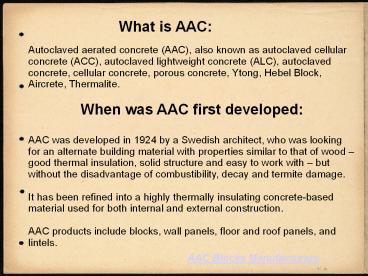AAC (Autoclaved Aerated Concrete) Blocks - PowerPoint PPT Presentation
Title:
AAC (Autoclaved Aerated Concrete) Blocks
Description:
Autoclaved aerated concrete (AAC), also known as autoclaved cellular concrete (ACC), autoclaved lightweight concrete (ALC), autoclaved concrete, cellular concrete, porous concrete, Ytong, Hebel Block, Aircrete, Thermalite. – PowerPoint PPT presentation
Number of Views:7217
Title: AAC (Autoclaved Aerated Concrete) Blocks
1
What is AAC Autoclaved
aerated concrete (AAC), also known as autoclaved
cellular concrete (ACC), autoclaved lightweight
concrete (ALC), autoclaved concrete, cellular
concrete, porous concrete, Ytong, Hebel Block,
Aircrete, Thermalite. When was
AAC first developed AAC was developed in 1924
by a Swedish architect, who was looking for an
alternate building material with properties
similar to that of wood good thermal
insulation, solid structure and easy to work with
but without the disadvantage of combustibility,
decay and termite damage. It has been refined
into a highly thermally insulating concrete-based
material used for both internal and external
construction. AAC products include blocks, wall
panels, floor and roof panels, and lintels.
AAC Blocks Manufacturers
2
3
Advantages AAC has been produced for more than
70 years, and it offers several significant
advantages over other cement construction
materials, one of the most important being its
lower environmental impact. Improved thermal
efficiency reduces the heating and cooling load
in buildings. Workability allows accurate
cutting, which minimizes the generation of solid
waste during use. Resource efficiency gives it
lower environmental impact in all phases of its
life cycle, from processing of raw materials to
the disposal of waste. Light weight saves cost
energy in transportation. Light weight saves
labor expenses. Light weight increases chances
of survival during seismic activity.
4
5
Larger size leads to faster masonry work.
Termite/Pest Resistant Cost Effective
Precision Earthquake Resistant Easy
Workability and Design Flexibility Thermally
Insulated Energy Efficient Fire Resistant
Eco-friendly
6
7
Sizes Both
blocks and panels are available. Blocks are
stacked similarly to conventional masonry, but
with a thin-bed mortar, and panels are stood
vertically, spanning full-story heights.
Panels extend from floor to top of the wall
Height up to 20 ft Width 24 in.
Thickness 6, 8, 10, or 12 in. (4 in. thick
interior partition panels are available)?
Blocks are larger and lighter than traditional
concrete masonry Height 8 in. typical
Width 24 in. long Thickness 4,
6, 8, 10, and 12 in. A standard 8 x 8 x
24 in. unit weighs about 33 lbs. Specialty
shapes U-shaped bond beam or lintel
blocks are available in thicknesses of 8, 10, and
12 in. Tongue and groove blocks are
available from some manufacturers, and these
connect to adjacent units without mortar at
vertical edges Cored blocks available
for creating vertical reinforced grouted cells
8
AAC Blocks Manufacturers
9
Manufacturing and Physical
Properties This manufacturing process produces a
lightweight, noncombustible material with the
following properties Density 20 to 50 pcf
(lb per cu ft)this is light enough to float in
water Compressive strength 300 to 900 psi
Allowable shear stress 8 to 22 psi
Thermal resistance 0.8 to 1.25 per in. of
thickness Sound transmission class (STC) 40
for 4 in. thickness 45 for 8 in. thickness
10
11
Installation, Connections and
Finishes Due to the similarity to traditional
concrete masonry, AAC units (block) can be easily
installed by concrete masons. Depending on the
type of finish selected, they can be directly
adhered or mechanically attached to the face of
AAC. Block First course is laid and leveled.
Blocks are stacked together with thin-bed mortar
in a running bond with a minimum of 6-in.
overlap. Walls are plumbed, leveled, and squared
with a rubber mallet. Openings and odd angles are
cut with a handsaw or bandsaw. Reinforcement
locations are determined, rebar placed, and
grouting occurs. Grout must be mechanically
vibrated to consolidate it. Bond beams are
placed at the top of the wall and can be used for
heavy-duty fixture attachment.
12
13
Panels Panels are placed one at a time,
starting from the corner. Panels are set into a
layer of thin-bed mortar and vertical rebar is
attached to dowels extending up from the floor
before the adjacent panel is placed. A
continuous bond beam is created at the top,
either with plywood and AAC material or with bond
beam block. Openings can be precut or field
cut. Connections Roof frame/framing is
connected to a conventional top plate or
hurricane straps embedded in the bond beam.
Floor framing is attached with standard ledgers
anchored to the side of the AAC assembly adjacent
to a bond beam. AAC floor systems bear
directly on top of AAC walls. Larger
structural steel members are set on weld plates
or bolt plates set into the bond beam.
14
15
Finishes Stucco-type
finishes are made specifically for AAC. These
polymer-modified plasters seal against water
intrusion yet allow moisture vapor for
breathability. Conventional siding materials are
mechanically attached to the wall face. Furring
strips should be employed if back ventilation of
the siding material is desirable. Masonry
veneers can be directly adhered to the wall face
or can be built as cavity walls. Direct-applied
veneers are typically lightweight materials like
manufactured stone.
AAC Blocks Manufacturers
16
17
18
19
20
AAC Blocks Manufacturers































